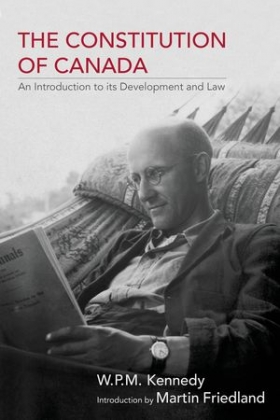By Martin Friedland, CC, QC, James M. Tory professor of law emeritus and former dean of law
In the spring of 2013, I was contacted by the University of Oxford Press. Oxford was reissuing W.P. M. Kennedy’s 1922 classic text, The Constitution of Canada. Would I write the introduction? I agreed to do so. It turned out to have been a fascinating project.
The founder of the University of Toronto Law School was an intriguing character. He never had a law degree and never took a course on law, yet, he became one of Canada’s preeminent legal scholars. For several generations his book on the constitution—one of his many books—was the best known and the most widely used text on the Canadian constitution.
The publication of Kennedy’s book was a major triumph and was responsible for establishing his reputation as the leading Canadian constitutional scholar of his generation. It traces the development of Canada from the earliest days of the French explorers until the date of publication. The reviews were excellent: “Alive, human, dramatic” wrote The Observer; “Brilliant” said Saturday Night; and “Masterly” from The Christian Science Monitor.
I was happy to undertake the task because I have a three-fold interest in Kennedy. Firstly, he was the first dean of the law school and I was its fourth. I thought that studying his life would give me a better understanding of the origins of the law school. I was also interested in Kennedy because I had learned something about his career while writing the history of the University of Toronto and realized then that he was one of the university’s most distinguished, engaging, and enigmatic personalities. Finally, I had a special interest in him because about 30 years ago my wife and I purchased—from his son Frere—the cottage Kennedy had owned since 1940, just west of Algonquin Park. The cottage still contained a good library and a trunkful of letters which I subsequently donated to the University of Toronto archives. The picture on the cover of the reissued text, showing Kennedy—at the age of 44—on a hammock at another cottage in 1923, was found in a trunk at our cottage.
I had a special interest in him because about 30 years ago my wife and I purchased—from his son Frere—the cottage Kennedy had owned since 1940, just west of Algonquin Park. The cottage still contained a good library and a trunkful of letters...
Kennedy’s career shows the twists and turns of life. He left home at age 14, but later graduated with honours from Trinity College Dublin. Over the next decade he spent considerable time at an Anglican monastery in England. His main interests when he came to Canada in 1913 were Tudor history and English literature. After a year at St. Francis Xavier College, he came to the University of Toronto. I have included an excerpt from my introduction dealing with his time at St. Francis Xavier and why he left for the University of Toronto. The excerpt is typical of his career before and after that period of his life. There are many mysteries to unravel. He destroyed his papers and so there are significant gaps in our knowledge. I have titled my introduction ‘The Enigmatic W.P.M. Kennedy.’
We do know that he moved from St. Michael’s College to the history department at the University of Toronto, but did not get along with its head, George Wrong, who wanted him out of the department. Kennedy’s marriage to one of his students, shortly after his first wife died in the Spanish influenza epidemic, played a role in the story. He unsuccessfully applied for positions in England and elsewhere in Canada, without success. Kennedy was then taken into the department of political economy, where he continued to teach constitutional history. But then in 1927 history was given jurisdiction over constitutional history and Kennedy had to find other subjects to teach. He taught federal constitutions in the law division of political economy, eventually taking over that division, then separating it from political economy, then establishing a separate school of law, and eventually in 1944, a separate faculty of law.
Kennedy developed a strong law school, with an interest in interdisciplinary studies, not unlike the present faculty of law, but with only a handful of professors. Throughout his career he was known as a stimulating and sparkling teacher. In 1935 Kennedy founded the University of Toronto Law Journal—the first scholarly legal journal in Canada and, arguably, the preeminent law journal in Canada from its inception. The journal reflected Kennedy’s view that ‘we study law as a social science, a great creative process of social engineering.’
‘Caesar’ Wright took over as dean in 1949 and the school became a second-entry professional faculty. Kennedy died in 1963 and is buried with his wife in a small cemetery not far from the cottage. He would, I’m sure, be proud to be known as the founder of the current law school.

